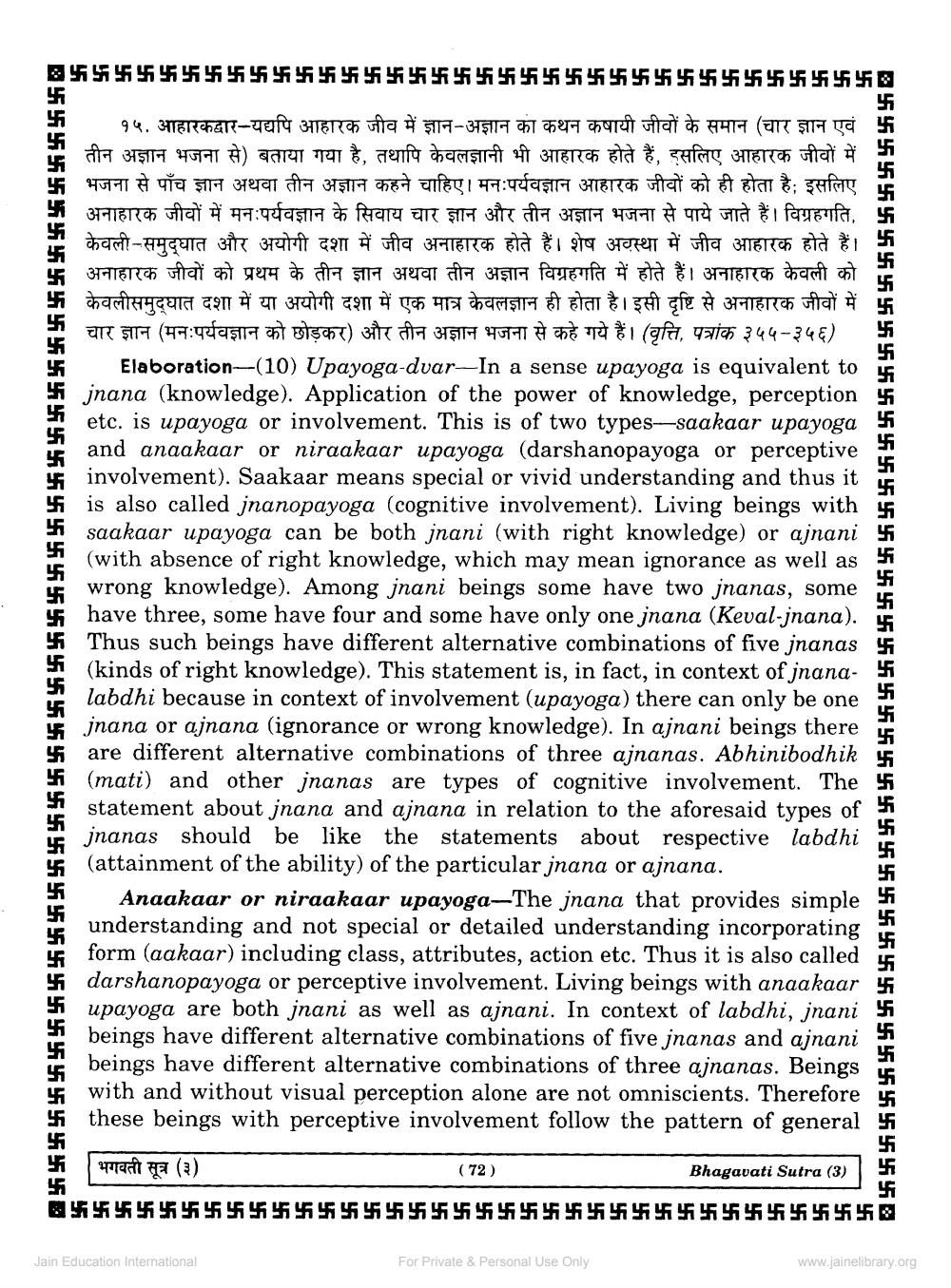________________
474 475 476 467 46 46 467 46 46 467 46 467 468 46 555555 46 467 467 46 467 4
557
*******************************மிதி
१५. आहारकद्वार - यद्यपि आहारक जीव में ज्ञान-अज्ञान का कथन कषायी जीवों के समान (चार ज्ञान एवं फ्र तीन अज्ञान भजना से) बताया गया है, तथापि केवलज्ञानी भी आहारक होते हैं, इसलिए आहारक जीवों में भजना से पाँच ज्ञान अथवा तीन अज्ञान कहने चाहिए । मनःपर्यवज्ञान आहारक जीवों को ही होता है; इसलिए अनाहारक जीवों में मनः पर्यवज्ञान के सिवाय चार ज्ञान और तीन अज्ञान भजना से पाये जाते हैं। विग्रहगति, केवली - समुद्घात और अयोगी दशा में जीव अनाहारक होते हैं। शेष अवस्था में जीव आहारक होते हैं। अनाहारक जीवों को प्रथम के तीन ज्ञान अथवा तीन अज्ञान विग्रहगति में होते हैं। अनाहारक केवली को केवलीसमुद्घात दशा में या अयोगी दशा में एक मात्र केवलज्ञान ही होता है। इसी दृष्टि से अनाहारक जीवों में चार ज्ञान (मनः पर्यवज्ञान को छोड़कर) और तीन अज्ञान भजना से कहे गये हैं। (वृत्ति, पत्रांक ३५५-३५६) Elaboration (10) Upayoga-dvar-In a sense upayoga is equivalent to jnana (knowledge). Application of the power of knowledge, perception etc. is upayoga or involvement. This is of two types-saakaar upayoga and anaakaar or niraakaar upayoga (darshanopayoga or perceptive involvement). Saakaar means special or vivid understanding and thus it is also called jnanopayoga (cognitive involvement). Living beings with saakaar upayoga can be both jnani (with right knowledge) or ajnani (with absence of right knowledge, which may mean ignorance as well as wrong knowledge). Among jnani beings some have two jnanas, some have three, some have four and some have only one jnana (Keval-jnana). Thus such beings have different alternative combinations of five jnanas (kinds of right knowledge). This statement is, in fact, in context of jnanalabdhi because in context of involvement (upayoga) there can only be one jnana or ajnana (ignorance or wrong knowledge). In ajnani beings there are different alternative combinations of three ajnanas. Abhinibodhik (mati) and other jnanas are types of cognitive involvement. The statement about jnana and ajnana in relation to the aforesaid types of jnanas should be like the statements about respective labdhi (attainment of the ability) of the particular jnana or ajnana.
Anaakaar or niraakaar upayoga-The jnana that provides simple understanding and not special or detailed understanding incorporating form (aakaar) including class, attributes, action etc. Thus it is also called darshanopayoga or perceptive involvement. Living beings with anaakaar upayoga are both jnani as well as ajnani. In context of labdhi, jnani beings have different alternative combinations of five jnanas and ajnani beings have different alternative combinations of three ajnanas. Beings with and without visual perception alone are not omniscients. Therefore these beings with perceptive involvement follow the pattern of general
भगवती सूत्र (३)
(72)
Jain Education International
555555555555555555555555555555
Bhagavati Sutra (3)
555555555555555555555555
For Private & Personal Use Only
www.jainelibrary.org




